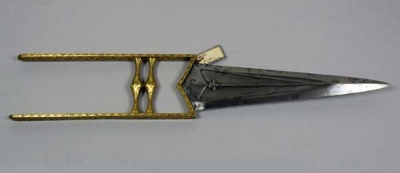Katar (1884.24.147)
 IndiaKatar from India, Asia. Part of the Pitt Rivers Museum Founding Collection. Given to the Museum in 1884.
IndiaKatar from India, Asia. Part of the Pitt Rivers Museum Founding Collection. Given to the Museum in 1884.
This is a katar, an armour-piercing weapon with a transverse punch grip that is unique to India. This example is larger than most examples with parallel wrist guards that extend to protect the forearm. Whereas the decoration on many katars is done using koftgari, a form of damascene work in which steel is inlaid with gold, here the niello technique is used.
Niello is a widely practised type of decoration, similar to koftgari in method, except that a bright surface such as gold or gilt-brass is incised and in-filled with niello rather than steel. Niello is a black alloy of sulphur, copper silver and often lead. Since the Indians derived niello technology from the Persians, it is likely this piece is of Moghul origin and so may date as far back as the 16th or 17th century.





